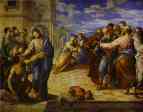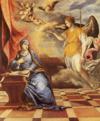El Greco Biography
The most unusual painter in 16th-century Europe, El Greco combined the strict Byzantine style of his homeland, Greece, with influences received during his studies in Venice and the medieval tradition of the country where he worked, Spain.
Domenicos Theotocopoulos, later called El Greco, the Greek, by the Spaniards, was born in Candia, on the island of Crete. Nothing is known of his parentage. He was trained as icon-maker in a monastery; he then went to Venice (soon after 1560), where Titian became his greatest mentor. El Greco, however, obtained very little influence from his master; but a certain influence of Bassano, Baroccio, Veronese, and Tintoretto could be felt but on the whole his works are very individual and distinct. In 1570, El Greco went by way of Parma (where he appreciated Correggio) to Rome, where he met Michelangelo. He criticized his Last Judgment severely, and offered to produce a better composition. But on the whole Michelangelo and the Central Italian Mannerists stimulated him. The works of his Italian period are very different in style: Christ Healing the Blind Man (1560s), The Annunciation (1570-1575), Christ Driving the Traders from the Temple (c.1570).
Around 1576, the painter went to Spain. At first he was in the service of Philip II: The Dream of Philip II (1579). His Martyrdom of St. Maurice (1580) did not appeal to Philip, and the painter moved to Toledo in 1580, the old capital and then a major center of artistic, intellectual, and religious life in 16th-century Spain. He stayed in Toledo until his death.
In 1586, he painted his famous The Burial of Count Orgaz (c.1586) for the church of St. Thomé, the success of which brought him a great number of commissions from the Church, the decoration of the new church of St. Domingo el Antiguo among them. He also became a popular portraitist: Portrait of a Nobleman with His Hand on His Chest (c.1580). His painting style always gave rise to much discussion.
The life of proud and independent El Greco in Spain, who always signed his pictures by his Greek name, demanded constant self-assertion. He rented the palace of Marquis Viliena (present Museum of El Greco in Toledo), collected a valuable library, was very successful in law suites against the church administration. Very brave in Catholic Spain was his union with a young aristocrat Jeronima de las Cuevas, mother of his bastard son Jorjé Manuel, the future Spanish architect. ‘Man of eccentric habits and ideas, of tremendous determination, extraordinary reticence, and extreme devoutness’ he was valued and respected by the intellectuals of Toledo. El Greco was buried in the Church of St. Thomé.
El Greco did not have followers, and his art was forgotten for 300 years. The re-discovery of his painting was a sensation; he became one of the most popular masters of the past, his painting rosed the interest of collectors, artists, lovers of art and art historians. El Greco is now regarded as one of the most important representatives of European Mannerism.
Bibliography
Painting of Europe. XIII-XX centuries. Encyclopedic Dictionary. Moscow. Iskusstvo. 1999.
El Greco: Identity and Transformation by Jose Alvarez Lopera, N. Hadjinicolau, C. Strinati, Museo thys, J. Alvarez Lapera. Skira, 1999.
El Greco in Toledo by Fernando Marias. Scala Books, 2001.
El Greco: The Burial of Count Orgaz. by F. Calvo Serraller, Francisco Calvo Serraller. Thames & Hudson, 1995.
El Greco by David Davies, John H. Elliott. Yale University Press, 2003.
From El Greco to Goya: Painting in Spain 1561-1828 by Janis Tomlinson. Prentice Hall, 2003.
El Greco (Masters of Art) by Leo Bronstein. Harry N Abrams, 1990.
El Greco and His Patrons: Three Major Projects (Cambridge Studies in the History of Art) by Richard G. Mann, Francis Haskell (Editor), Nicholas Penn. Cambridge University Press, 1986.
- Christ Healing The Blind Man.

1560s. Oil on panel. Alte Meister Gallerie, Dresden, Germany. Read Note.
- The Annunciation.

1570-1575. Oil on canvas. Thyssen-Bornemisza Collection, Lugano-Castagnola, Switzerland. Read Note.
- Christ Driving The Traders From The Temple.

c.1570. Oil on panel. National Gallery of Art, Washington, DC, USA. Read Note.